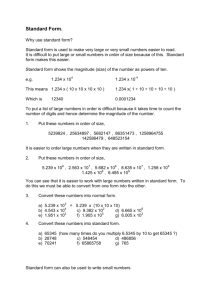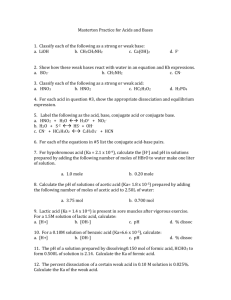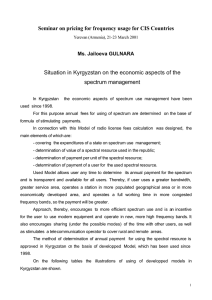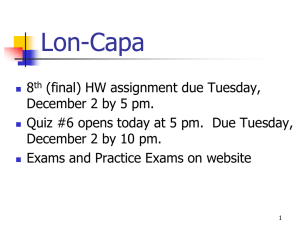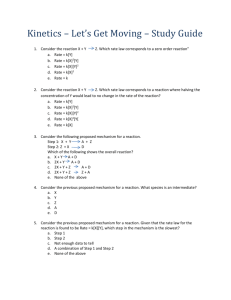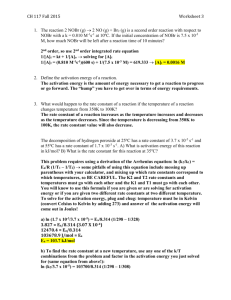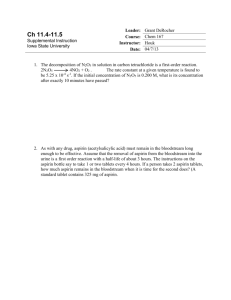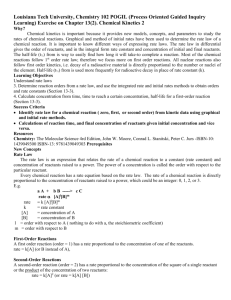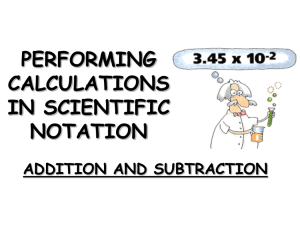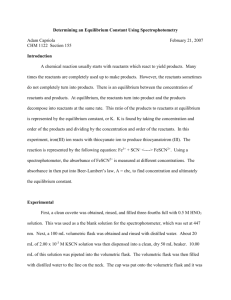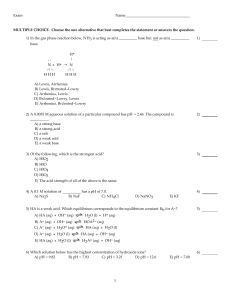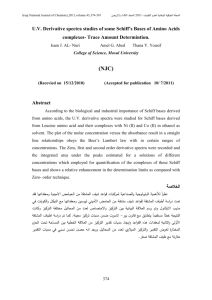A first order reaction has a rate constant of 1
advertisement
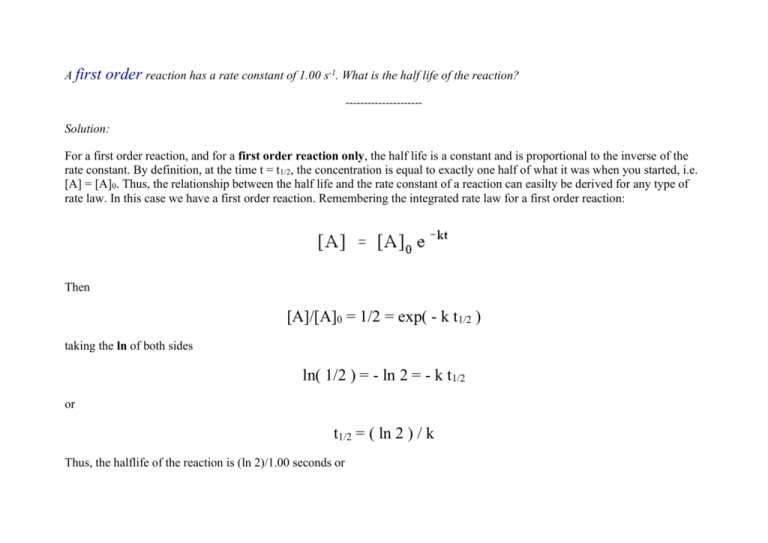
A first
order reaction has a rate constant of 1.00 s-1. What is the half life of the reaction?
---------------------
Solution:
For a first order reaction, and for a first order reaction only, the half life is a constant and is proportional to the inverse of the
rate constant. By definition, at the time t = t1/2, the concentration is equal to exactly one half of what it was when you started, i.e.
[A] = [A]0. Thus, the relationship between the half life and the rate constant of a reaction can easilty be derived for any type of
rate law. In this case we have a first order reaction. Remembering the integrated rate law for a first order reaction:
Then
[A]/[A]0 = 1/2 = exp( - k t1/2 )
taking the ln of both sides
ln( 1/2 ) = - ln 2 = - k t1/2
or
t1/2 = ( ln 2 ) / k
Thus, the halflife of the reaction is (ln 2)/1.00 seconds or
t1/2 = 0.6931 s
For any order other than first order, the halflife of the reaction is dependent on the concentration. See the table for the formula
for zeroth and second order reactions.
An elementary reaction, 2 A + C --> D, is second order in A and first order in C. The rate of this reaction is 2.5 x 101
M/s when the concentrations of A, C, and D are all 1.00 mM. What is the rate constant for the reaction?
-------------------------
Solution:
The rate law for the reaction is
rate = k [A]2[C]
Since we know the instantaneous rate of the reaction at known concentrations, we can directly evaluate the rate constant
2.5 x 10-1 M/s = k (1.00 x 10-3 M)2 (1.00 x 10-3 M)
k = 2.5 x 108 M-2s-1
This is the appropriate units of a rate constant for a reaction that is third order overall.
The rate constant for the reaction
H2(g) + I2(g) ---> 2HI(g)
is 5.4 x 10-4 M-1s-1 at 326 oC.
At 410 oC the rate constant was found to be 2.8 x 10-2 M-1s-1.
Calculate the
a) activation energy
and
b) high temperature limiting rate constant
for this reaction.
-------------------------
Solution:
All reactions are activated processes. Rate constant is exponentially dependent on the Temperature
We know the rate constant for the reaction at two different temperatures and thus we can calculate the activation energy from
the above relation. First, and always, convert all temperatures to Kelvin, an absolute temperature scale. Then simply solve for Ea
in units of R.
ln(5.4 x 10-4 M-1s -1/ 2.8 x 10-2 M-1s-1) = (-Ea /R ){1/599 K - 1/683 K}
-3.9484 = - Ea/R {2.053 x 10-4 K-1}
Ea= (1.923 x 104 K) (8.314 J/K mol)
Ea= 1.60 x 105 J/mol
Now that we know Ea, the pre-exponential factor, A, (which is the largest rate constant that the reaction can possibly have) can
be evaluated from any measure of the absolute rate constant of the reaction.
so
5.4 x 10-4 M -1s-1 =
A exp{-(1.60 x 105 J/mol)/((8.314 J/K mol)(599K))}
(5.4 x 10-4 M-1s-1) / (1.141x10-14) = 4.73 x 1010 M-1s-1
The infinite temperature rate constant is 4.73 x 1010 M-1s-1
Consider the first order reaction
A ---> products
which has a rate constant, k = 2.95 X 10-3 s-1. What percent of A remains after 150 s ?
---------------
Solution:
For a first order reaction, the integrated rate law is:
The fraction remaining is the concentration divided by the initial concentration or [A]/[A]0 thus
fraction remaining = exp{-(2.95 X 10-3 s-1) (150 s)} = 0.642
or
64.2%
The reaction A --> products is second order in A. Initially [A] 0 = 1.00 M; and after 25 mins, [A] = 0.25 M. What is the rate
constant for this reaction?
-----------------
Solution:
The integrated rate law for a second order reaction is:
Since we know the concentration initially and at some later time, we can simply solve for k.
1/0.25 M = 1/1.00M + k(25 min)
3.00 M-1/(25 min) = k = 1.2 x 10-1 M-1min-1
The decomposition of N2O5 is given by the following equation
2 N2O5(g) ----> 4 NO2(g) + O2(g)
At an initial [N2O5]0 = 3.15 M, the initial rate of reaction is 5.45 X 10-5 M/s and when [N2O5]0 = 0.78 M, the initial rate of
reaction is 1.35 X 10-5 M/s. What is the rate constant of this reaction?
------------------------
Solution:
This is an initial rates problem. There is only one reactant, so our life is simple. We make a dimensionless ratio of two rates and
equate that to a rate law with an as yet an undetermined order.
(5.45 X 10-5 M/s) / (1.35 X 10-5 M/s) = (3.15 M)a / (0.78 M)a
4.037 = (4.039)a
a=1
Now that we know the order or the reaction is one, we can solve for the rate constant:
5.45 X 10-5 M/s = k (3.15 M)
k = 1.73 x 10-5s-1
We can check this by using the other set of conditions
1.35 X 10-5 M/s = k (0.78 M)
k = 1.73 x 10-5 s-1
Everything if fine.
The initial rate of the reaction
the following table:
2A + 2B ---> C + D is determined for different initial conditions, with the results listed in
Run #
[A]0, M
[B]0, M
Initial rate, M/s
1
0.185
0.133
3.35 x 10-4
2
0.185
0.266
1.35 X 10-3
3
0.370
0.133
6.75 X 10-4
4
0.370
0.266
2.70 X 10-3
Find the rate law and rate constant for this reaction.
-----------------------
Solution:
This, too, is an initial rates problem. There is more than on species present as a rectant, so we must isolate the effect of each of
the reactants' concentrations on the overall rete of reaction. Runs number 1 and 3 have the same concentration of B but the
concentration of A doubles. The rate of the reaction doubles too, so the reaction is first order in A. Runs number 1 and 2 have the
concentration of A the same but the concentration of B doubles. The rate quadruples under these conditions so the reaction is
second order in B. Thus the rate law is
rate = k[A][B]2
The rate constant may be evaluated with any set (row) of data. Try run #1
3.35 x 10-4 M/s = k(0.185 M)(0.133 M)2
k = 0.102 M-2 s-1
As a check, lets use run #4
2.70 x 10-3 M/s = k(0.370 M)(0.266 M)2
k = 0.103 M-2 s-1
Determine the order of the reaction A
--> 2B + C from the following data obtained for [A] as a function of time.
time
[A]
0 min
0.80 M
8 mins
0.60 M
24 mins
0.35 M
40 mins
0.20 M
-----------------
Solution:
This, unfortunately is not an initial rates problem. We have not been provided with data spaced close enough to get an
instantaneous rate under known reactant concentrations. So we must directly test the integrated rate laws for validity.
If the reaction were zeroth order, the change in concentration divided by the elapsed time would be a constant. Let's see if this is
true:
(0.80 - 0.60) / 8 = 0.0250
(0.80 - 0.35) / 24 = 0.0188
(0.80 - 0.20) / 40 = 0.0150
Nope, it is not zeroth order.
If the reaction were second order, the change in inverse concentration divided by the elapsed time would be constant.
(1/0.60 - 1/0.80) / 8 = 0.0521
(1/0.35 - 1/0.80) / 24 = 0.0670
(1/0.20 - 1/0.80) / 40 = 0.0938
Nope, it's not second order either.
If the reaction is first order, the change in the natural log of the concentration divided by the elapsed time will be constant.
(ln(0.80) - ln(0.60)) / 8 = 0.0360
(ln(0.80) - ln(0.35)) / 24 = 0.0344
(ln(0.80) - ln(0.20)) / 40 = 0.0347
Looks Good! The reaction is first order and the rate constant is 0.035 min-1
